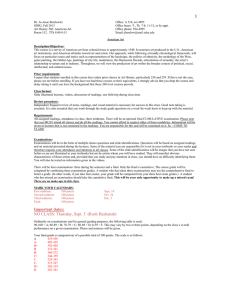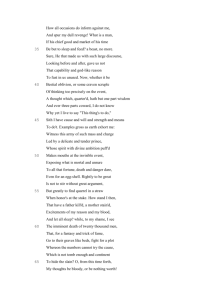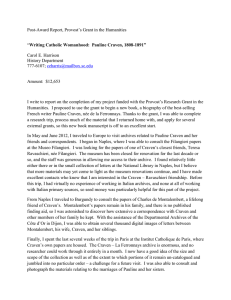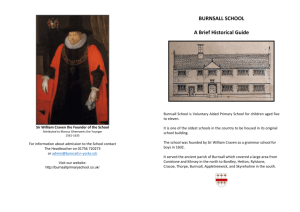1
advertisement
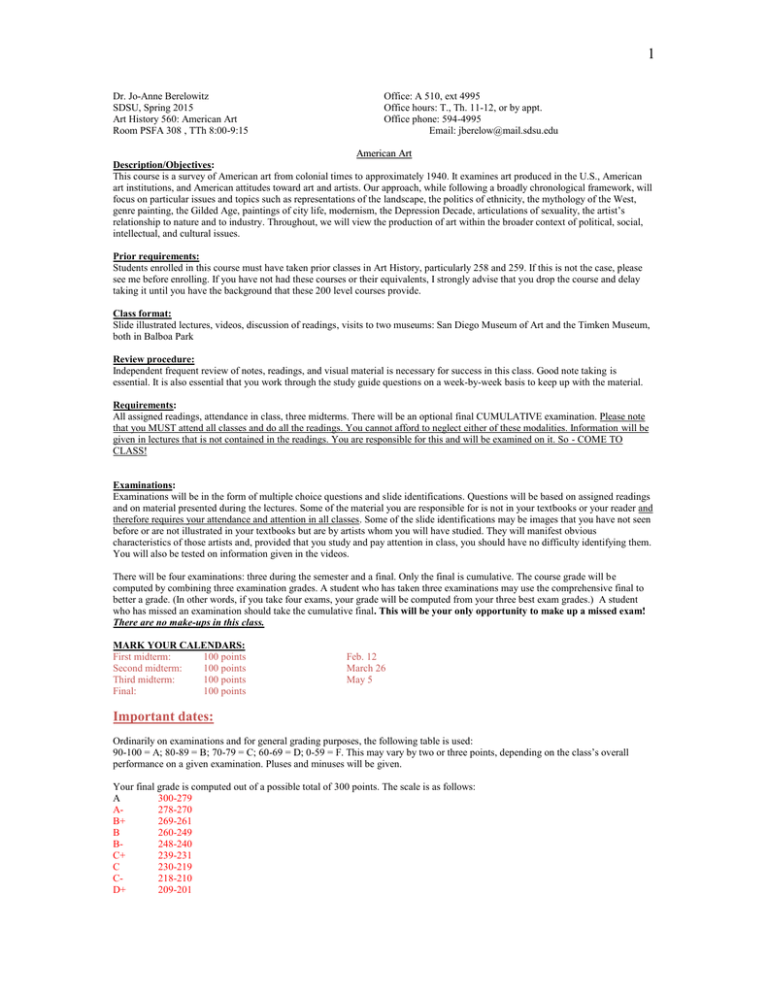
1 Dr. Jo-Anne Berelowitz SDSU, Spring 2015 Art History 560: American Art Room PSFA 308 , TTh 8:00-9:15 Office: A 510, ext 4995 Office hours: T., Th. 11-12, or by appt. Office phone: 594-4995 Email: jberelow@mail.sdsu.edu American Art Description/Objectives: This course is a survey of American art from colonial times to approximately 1940. It examines art produced in the U.S., American art institutions, and American attitudes toward art and artists. Our approach, while following a broadly chronological framework, will focus on particular issues and topics such as representations of the landscape, the politics of ethnicity, the mythology of the West, genre painting, the Gilded Age, paintings of city life, modernism, the Depression Decade, articulations of sexuality, the artist’s relationship to nature and to industry. Throughout, we will view the production of art within the broader context of political, social, intellectual, and cultural issues. Prior requirements: Students enrolled in this course must have taken prior classes in Art History, particularly 258 and 259. If this is not the case, please see me before enrolling. If you have not had these courses or their equivalents, I strongly advise that you drop the course and delay taking it until you have the background that these 200 level courses provide. Class format: Slide illustrated lectures, videos, discussion of readings, visits to two museums: San Diego Museum of Art and the Timken Museum, both in Balboa Park Review procedure: Independent frequent review of notes, readings, and visual material is necessary for success in this class. Good note taking is essential. It is also essential that you work through the study guide questions on a week-by-week basis to keep up with the material. Requirements: All assigned readings, attendance in class, three midterms. There will be an optional final CUMULATIVE examination. Please note that you MUST attend all classes and do all the readings. You cannot afford to neglect either of these modalities. Information will be given in lectures that is not contained in the readings. You are responsible for this and will be examined on it. So - COME TO CLASS! Examinations: Examinations will be in the form of multiple choice questions and slide identifications. Questions will be based on assigned readings and on material presented during the lectures. Some of the material you are responsible for is not in your textbooks or your reader and therefore requires your attendance and attention in all classes. Some of the slide identifications may be images that you have not seen before or are not illustrated in your textbooks but are by artists whom you will have studied. They will manifest obvious characteristics of those artists and, provided that you study and pay attention in class, you should have no difficulty identifying them. You will also be tested on information given in the videos. There will be four examinations: three during the semester and a final. Only the final is cumulative. The course grade will be computed by combining three examination grades. A student who has taken three examinations may use the comprehensive final to better a grade. (In other words, if you take four exams, your grade will be computed from your three best exam grades.) A student who has missed an examination should take the cumulative final. This will be your only opportunity to make up a missed exam! There are no make-ups in this class. MARK YOUR CALENDARS: First midterm: 100 points Second midterm: 100 points Third midterm: 100 points Final: 100 points Feb. 12 March 26 May 5 Important dates: Ordinarily on examinations and for general grading purposes, the following table is used: 90-100 = A; 80-89 = B; 70-79 = C; 60-69 = D; 0-59 = F. This may vary by two or three points, depending on the class’s overall performance on a given examination. Pluses and minuses will be given. Your final grade is computed out of a possible total of 300 points. The scale is as follows: A 300-279 A278-270 B+ 269-261 B 260-249 B248-240 C+ 239-231 C 230-219 C218-210 D+ 209-201 2 D 200-189 D- 188-180 Policy for missed exams: A missed exam will count as an F grade unless the student has an authorized excuse. Illness must be substantiated by a physician’s letter, work-related absence by a letter from an employer. Other reasons for absence will need to be cleared with the professor. There will be no makeups under any circumstances. Students who miss an exam for whatever reason may take the optional cumulative final. Early exams are not an option. Student responsibility: It is your responsibility to attend class regularly, to make up missed information if absence is unavoidable, to stay current in terms of course material, and to prepare for examinations. If you experience difficulties with course material, it is your responsibility to schedule conferences with the professor. Readings: Two books have been ordered for you: Wayne Craven: American Art: History and Culture, Brown and Benchmark, 1994. Marianne Doezema and Elizabeth Milroy: Reading American Art, Yale, 1998. Office Hours: Tuesdays and Thursdays7:30-8:00; 11-12 or by appointment. I encourage you to take advantage of office hours and to use this time to discuss the readings, difficulties you might be having with the course, writing skills, or any other matters pertaining to the course. It’s best to catch problems early! I will sometimes have a faculty meeting scheduled during my usual office hour time. This makes it important to check with me regarding my availability for each office hour period. Cheating and plagiarism: The penalty for cheating is an F in the class and being reported to the University’s judicial officer. Plagiarized work will be penalized to the fullest extent possible and will very likely result in expulsion from the university and/or delay of graduation. If you are caught cheating, it will go on your record. More administrative details: In Incomplete may be issued under appropriate circumstances, in which case a contract must be signed by both student and professor. The contract form is available in the School of Art Office, located in A-505. An Incomplete is not a substitute for an “F.” If no arrangements have been made and assignments are missing, a “U” will be automatically issued. It is all but impossible to withdraw from a course after the official drop date, so please do so before that date, should you want or need to drop this course. University restrictions on issuing Incompletes and granting course withdrawals after the official drop deadline are very stringent. Even if you have submitted a petition to withdraw from a course, continue to attend until permission has been officially granted and confirmed in writing by the University. If you are taking the course in order to remove a grade lower than C (C- or below), you must file a petition for “Course Forgiveness” with Admissions and Records. If you are taking this course Credit/No Credit, Credit is a cumulative “C” according the University regulations. All assignments must be completed with a cumulative grade of “C” (not “C-“) in order for Credit to be earned. Keep all returned assignments until after you have received your final grade report from the Registrar’s office. If you anticipate needing to ask for a letter of recommendation to graduate school, keep all graded assignments for me to review before I write the letter. “Graduating Seniors” who earn an F in this class will receive an F. Any student who receives an F on an examination should see me immediately during office hours. If your grade is lower than a C, I strongly advise that you consult with me. Students who are completing Incompletes from previous semesters must meet this semester’s deadlines and follow this semester’s assignments. The Love Library offers useful library tours. If you find yourself receiving Ds or Fs, you should consider signing up for tutoring services through the Student Affairs Office or the Study Skills Center. Graduate students are required to produce a paper, approximately 15 pages. Please see me ASAP to discuss a topic. This will be in lieu of one exam. In other words, graduate students will take two exams and write one paper. Each component is worth 100 points. Students with Disabilities Students who need accommodation of their disabilities should contact me privately, to discuss specific accommodations for which they have received authorization. If you need accommodation due to a disability, but have not registered with Student Disability Services at 619-594-6473 (Calpulli Center, Suite 3101), please do so before making an appointment to see me. Schedule of Classes and Readings: (Please note that this schedule is approximate and may be modified.) An * denotes an article from Reading American Art. 3 Week 1 Thu. Jan. 22 Introduction --A vision of paradise: the European concept of America The Colonial Period: portraits --the Freakes, Smibert, Feke, Copley Required reading: Craven. 42-47 (the 17th c), 68-74 (1700-50), 99-102 (Copley); 104-108 (Peale) *Wayne Craven. “The Seventeenth-Century New England Mercantile Image”, 1-11. *Staiti, “Character and Class. . . .” 12-37. -------------------------------------------------------------------------------Week 2 Tues. Jan 27 The Federal Period: History and Portrait Painting --West, Copley, Trumbull, Stuart, Vanderlyn Thu. Jan 29 The Federal Period: History and Portrait Painting, contd --Peale family; portraits of Washington Required reading: Craven: West 135-139; Trumbull 139-141; Stuart 141-143; Vanderlyn 146-147; Peale 104-107 ------------------------------------------------------------------------------------Week 3 Feb. 3 Millenialism and apocalypse --Washington Allston Feb. 5 Manifest Destiny, apocalypse, nationalism, and the American landscape/American nature --Cole, Durand, Church, Bierstadt, Moran --Industrializing the American landscape --America’s birds: Audubon The Feminized Sublime --Kensett, Gifford, Lane Required reading: Craven. Allston 148-149; Washington 107; 142-143; 166; 149-150; 198-211 (Cole, Durand, Church, Bierstadt); 214-219 (Luminism, Moran), 161 (Audubon) *Alan Wallach. “Thomas Cole and the Aristocracy,” 79-108. * Nancy Anderson. “’The Kiss of Enterprise’: The Western Landscape as Symbol and Resource,” 208-231. -------------------------------------------------------------------------------------Week 4 Feb. 10 Picturing/Inventing "the Indian" --Catlin, King, Bingham, Stanley, Deas, Tait. Federal Commissions in the Capitol --The politics of ethnicity in the US Capitol, 1815-1860 Feb. 12 First midterm You are responsible for all material covered thus far (including the Audubon movie). Required reading: Craven. 213 (Catlin), 228-229 (Bingham);252-253 (Crawford) *Kathryn S. Hight. “’Doomed to Perish,’ George Catlin’s Depictions of the Mandan.” 150-162. -------------------------------------------------------------------------------------FEBRUARY 14: VISIT TO SAN DIEGO MUSEUM OF ART TO VIEW “AMERICAN VISIONS: PLACE AND IDENTITY”. STUDENTS ARE ALSO EXPECTED TO VISIT THE TIMKEN MUSEUM OF ART --------------------------------------------------------------------------------------Week 5 Feb. 17 Genre and Folk painting; representing the West 4 --Picturing progress: Woodville, Ranney, Bingham, Leutze, Palmer, etc --satire, coded comments (Mount) --representations of African-Americans Feb. 19 The Civil War --representations of battle and slavery --Winslow Homer -- Edmonia Lewis Required reading: Craven. 221-227 (Genre), 329-330 (Johnson) 334-338 (Homer), 257-258 (Lewis), 241-248 (Brady, etc * William T. Oedel and Todd S. Gernes. “The Painter’s Triumph: William Sidney Mount and the Formation of a Middle-Class Art,” 128-149. * Kirsten P. Buick, “”The Ideal Works of Edmonia Lewis: Invoking and Inverting Autobiography,” 190-207 -------------------------------------------------------------------------------------Week 6 Feb. 24 Mythologizing the American West, 1880-1920 --Remington, Russell The Gilded Age --Winslow Homer Feb. 26 The Gilded Age, contd. --Thomas Eakins: painter and photographer -- Henry Ossawa Tanner Required reading: Craven., 387-389 (Remington) 334-338 (Homer), 338-341 (Eakins), Tanner 346 *Jules D. Prown. “Winslow Homer in His Art,” 264-279. *Elizabeth Johns. “The Gross Clinic, or Portrait of Professor Gross,” 252-263. ------------------------------------------------------------------------------------Week 7 March 3 Thomas Eakins movie March 5 The Gilded Age, contd. --Ryder --Master illusionists: Harnett and Peto --William Merritt Chase Required reading: Craven, 362-364 (Ryder); 365-367 (Harnett and Peto) 362-364 (Ryder); 349-350 (Chase) ------------------------------------------------------------------------------------Week 8 March 10 Gilded Age Expatriates --Whistler, Sargent, Cassatt March 12 A Gilded Age Collector and her dealer --Isabella Stuart Gardner and Bernard Berenson Required reading: Craven, 342-349 (Whistler, Sargent, Cassatt) *Griselda Pollock. “Mary Cassatt: Painter of Women and Children.” ----------------------------------------------------------------Week 9 March 17 Representing women in 19th century sculpture --Queens and captives --the Greek Slave Representing modern life --Ash Can School Realism: Robert Henri and the Eight; Bellows --Hopper March 19 5 NO CLASS TODAY BECAUSE OF THE MUSEUM VISIT WHICH SERVES IN LIEU OF CLASS Required reading: Craven. 422-429 (Ashcan), 435-436 (Hopper) Robert E. Haywood. “George Bellows’s Stag at Sharkey’s: Boxing, Violence, and Male Identity,” Critical Issues in American Art, ed. Mary Ann Calo, Icon, 1998, 243-252. -------------------------------------------------------------------------------------Week 10 March 24 American Modernists -- Stieglitz and “291” March 26 SECOND MIDTERM You are responsible for all material covered since the first midterm Required reading: Craven. 444-446 (disc. Modernism), 452 (291), 469-472 (Stieglitz), 457-458 (O’Keeffe) -------------------------------------------------------------------------------------Week 11 March 30-April 3 SPRING BREAK --------------------------------------------------------------------------------------Week 12 April 7 American Modernists --O’Keeffe April 9 American Modernists, contd. -- Marin, Hartley, Dove --Demuth Required reading: *Anna C. Chave. “O’Keeffe and the Masculine Gaze,” 350-370. Craven. 464-465, 455 (Marin), 457 (Hartley), 456 (Dove), 475 (Sheeler), 460 -461(Arensberg), 461 (Man Ray) ----------------------------------------------------------------------------------Week 13 April 14 American Modernists, contd. --The Arensberg Circle --American Dada April 16 --Sheeler Required reading: Craven. 464-465, 455 (Marin), 457 (Hartley), 456 (Dove), 475 (Sheeler), 460 -461(Arensberg), 461 (Man Ray) ----------------------------------------------------------------------------------Week 14 April 21 American women modernists --Gertrude Stein --Florine Stettheimer --The Armory Show A Marxist paints an image of American capitalism --Diego Rivera in the United States April 23 The Depression Decade: Regionalism and the New Deal --Benton, Curry, Wood Required reading: Linda Nochlin. “Florine Stettheimer: Rococo Subversive,” Critical Issues in American Art, ed. Mary Ann Calo, Icon, 1998, 303-318. Max Kozloff. "The Rivera Frescoes of Modern Industry at the Detroit Institute of Arts: Proletarian Art under Capitalist Patronage," Artforum 12 (Nov.1973): 58-63. Craven. 439-443 (Regionalists) 556-563 6 Thomas Hart Benton. “On Regionalism, 1951. McCoubrey 201-206. *Wanda M. Corn. “The Birth of a National Icon: Grant Wood’s American Gothic,” 387-408. --------------------------------------------------------------------------------Week 15 April 28 Abstract Expressionism: American Art Ascendant -Gorky -Hans Hofmann -Pollock April 30 Abstract Expressionism: American Art Ascendant, contd. De Kooning, Rothko, Newman Required reading: Craven: 551-554; 556-557; 560, 562; 567 ----------------------------------------------------------------------------Week 16 May 5 THIRD MIDTERM May 7 return of exams; question time
